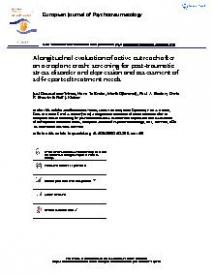A longitudinal evaluation of active outreach after an aeroplane crash : screening for post-traumatic stress disorder and depression and assessment of self-reported treatment needs
Background: In 2009, an aeroplane crashed near Amsterdam. To remedy unmet mental health needs, active outreach was used to identify victims at risk for post-traumatic stress disorder (PTSD) and depression.
Objective: The active outreach strategy was evaluated by examining the accuracy of screening methods in predicting PTSD and depression, self-reported treatment needs, and the extent to which perceived treatment needs predict trajectories of PTSD.
Method: In 112 adult survivors, semi-structured telephone interviews were held at 2 (T1, n = 76), 9 (T2, n = 77) and 44 months (T3, n = 55) after the crash. The Trauma Screening Questionnaire (TSQ) and the Patient Health Questionnaire-2 (PHQ-2) measured symptoms of PTSD and depression, respectively. At T3, a clinical interview assessed PTSD and depression diagnoses. Based on the TSQ scores at the three time-points, participants were grouped into five ‘trajectories’: resilient (n = 38), chronic (n = 30), recovery (n = 9), delayed onset (n = 9) and relapse (n = 3).
Results: The TSQ accurately predicted PTSD at T3 (sensitivity: .75–1.00; specificity: .79–.90). The PHQ-2 showed modest accuracy (sensitivity: .38–.89; specificity: .67–.90). Both measures provided low positive predictive values (TSQ: 0.57; PHQ-2: .50 at T3). A number of participants reported unmet treatment needs (T1: 32.9%; T2: 19.5%; T3: 10.9%). Reporting unmet needs at T2 was more often assigned to a chronic PTSD trajectory compared to reporting no needs (p < .01).
Conclusions: The prevalence of unmet needs at 44 months after the crash within a chronic PTSD trajectory indicated that active outreach may be warranted. Nevertheless, although the TSQ was accurate, many participants screening positive did not develop PTSD. This implies that, although active outreach may benefit those with unmet needs, it also has its costs in terms of possible unnecessary clinical assessments.
In: European Journal of Psychotraumatology, ISSN 2000-8198 ; eISSN 2000-8066 | 10 | 1 | 1554406
https://doi.org/10.1080/20008198.2018.1554406


